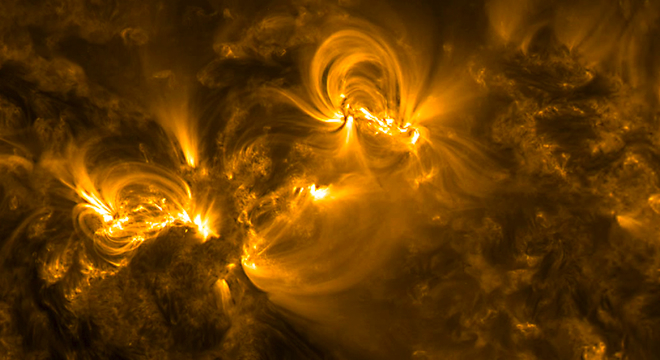One of the most-hyped new product categories to be demonstrated at the 2013 annual Consumer Electronics Show (CES) in Las Vegas last week were new “4K” ultra-high definition TVs, that is, TVs with over 4,000 pixels on one or both sides.
Sony, Samsung, LG, Toshiba and Panasonic showed off their own 4K models, and Panasonic even demoed a 4K 20-inch tablet.
But beside the extremely high starting price (upwards of $20,000 for 84-inch sets, although Sony has claimed that upcoming 55-inch and 60-inch models will be more affordable when released later this year), a major problem facing adoption of these new Ultra HD sets is the lack of content.
Enter NASA: On Monday, the U.S. space agency announced that it has collected enough ultra HD imagery of the Sun to allow viewers using the new 4K sets to “watch eight hours of sun movies a day for almost four months.”
The imagery was captured by NASA’s Solar Dynamics Observatory, an Earth-orbiting, sun-gazing satellite launched by the agency in 2010 specifically to study our star’s magnetic field, surface, underlying processes and the weather it produces throughout the universe and here on Earth.
Here’s a NASA diagram released Monday showing how its SDO imagery compares to 4K TV set definition and to regular HD TVs:

“Six of the cameras on the Solar Dynamics Observatory are 4096 x 4096 pixels, twice that of an UltraHD display,” wrote NASA solar scientist William D. Pesnell in an email to TPM.
“They started taking pictures of the Sun in May 2010, and have returned about 100 million images.”
NASA has collected the imagery in such high definition to study up-close features on the Sun that are as small as 200 miles across (the Sun itself is 875,000 miles across).
“Our primary purpose is to study the magnetic field of the Sun, from small details to the whole Sun,” explained Pesnell. “To do that we want to see the the full disk of the Sun at highest possible resolution. SDO has seen that small events, such as flares or active regions poking through the surface, can rearrange the global magnetic field of the Sun.”
He continued:
“Instruments that focus on small regions of the Sun often see material enter and leave their images. Although these extremely high resolution data are very useful, they rely on the full-disk images to make sure we don’t miss a source of mass or energy.”
But because the imagery is in such high definition, and the new 4K TVs haven’t been available on the market for the initial phase of the SDO mission, NASA has used multiple TV sets to view the imagery at full size.
“Members of the SDO team at Lockheed in Palo Alto, CA built an SDO Video Wall out of separate monitors to look at the raw images,” Pesnell told TPM. “People at Goddard have also built multi-monitor walls to display the images.”
Still, NASA prefers that mode right now and has no current plans to pay the hefty price of the new 4K TV sets.
“We are looking at the UltraHD TVs but do not immediate plans to purchase them,” Pesnell told TPM. “The prices of most of the sets are not available so it is hard to make plans right now. We would use them as monitors rather than TV sets.”









